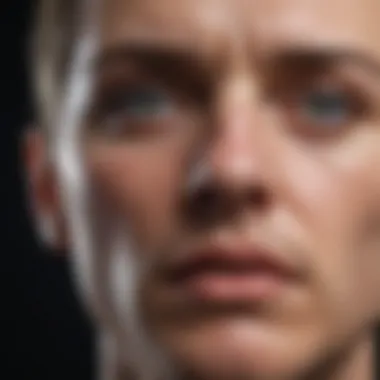Understanding Visual Aura Migraines: Causes and Mechanisms


Intro
Visual aura migraines are a complex and often misunderstood phenomenon. Unlike standard migraines, visual aura experiences involve distinct visual disturbances that precede or accompany the headache phase. Understanding these migraines requires an exploration into their foundational causes, mechanisms, and triggers. This investigation sheds light on how these migraines manifest and their intricate relationship with the brain’s neurological functions.
The main goal of this article is to provide a thorough overview of visual aura migraines, delving into the scientific discussions surrounding their etiology. Moreover, we will analyze how lifestyle and environmental factors contribute to their occurrence, impacting individuals' overall health and well-being. Given the rise in prevalence and recognition of these specific types of migraines, understanding their nuances becomes a pressing necessity for both health professionals and those affected.
Research Overview
Summary of Key Findings
Recent studies have revealed several key insights regarding visual aura migraines. Research shows that these migraines often originate from cortical spreading depression—a wave of neuron activation followed by a period of inhibition. This phenomenon explains the transient visual distortions experienced by individuals. Additionally, genetic predispositions and environmental triggers, such as stress and hormonal fluctuations, play vital roles in migraine onset.
Research has indicated that certain individuals may have a greater susceptibility due to genetic factors, including variants in the CALCA and KCNK18 genes, which are linked to migraine pathophysiology. Furthermore, functional MRI studies demonstrate that these auras often correlate with specific brain activity patterns, thereby linking them directly to cerebral function.
Relevance to Current Scientific Discussions
Visual aura migraines have become a focal point in neurology and migraine research. The investigation into underlying causes and potential triggers is increasingly relevant, especially as millions experience migraines worldwide. The relationship between visual aura migraines and other types of migraines is an area ripe for exploration. Understanding these nuances can lead to enhanced treatment strategies and improved quality of life for those affected.
Emerging discussions also address how lifestyle adaptations and preventive measures can reduce migraine frequency and severity. This includes recognizing potential triggers within daily routines, such as food, sleep patterns, and stress management.
"Understanding the mechanisms behind visual aura migraines can lead to better patient care and management. Knowledge is crucial in mitigating impacts on mental health and productivity."
By dissecting these components, we aim to contribute meaningfully to the ongoing scientific discourse
Methodology
Research Design and Approach
A multi-faceted research design was employed to thoroughly investigate visual aura migraines. This includes both qualitative and quantitative approaches, encompassing clinical studies, patient surveys, and neurological assessments.
Data Collection and Analysis Techniques
Data was collected through various means, such as:
- Neuroimaging studies to monitor brain activity during auras.
- Patient questionnaires to identify triggers.
- Genetic analysis to understand predispositions.
Statistical analysis was utilized to interpret findings, offering insights into correlations between various triggers and the incidence of visual aura migraines. Through this systematic approach, a more profound understanding of the topic emerged, ensuring that the findings are reliable and applicable to real-world scenarios.
By unpacking the layers of visual aura migraines, we hope to provide clarity on this intricate subject matter, designed to inform students, researchers, and health professionals alike.
Preamble to Visual Aura Migraines
Visual aura migraines are a unique subset of migraines characterized by distinct visual disturbances that precede or accompany the headache phase. Understanding this neurological phenomenon is important for both patients and healthcare professionals. The intricacies of visual aura migraines exemplify the complex relationship between the brain and perception, creating a compelling area of study in both clinical and research settings.
The presentation of visual auras can include shimmering lights, zigzag patterns, or blind spots, often inducing confusion and apprehension in individuals experiencing them. People who suffer from these migraines often search for explanations and effective management strategies. This article is designed to dissect the nature of visual aura migraines comprehensively. We explore the underlying causes, the physiology linking them to brain function, and various potential triggers that can exacerbate the condition.
An accurate understanding of visual aura migraines can lead to better treatment options and improved quality of life. By outlining the essential components of this subject, the article provides insights that may aid both patients and medical practitioners in navigating the complexities of visual aura migraines. From genetic predispositions to environmental factors, we will cover an array of considerations that shape this multifaceted condition.
Physiological Mechanisms
Understanding the physiological mechanisms behind visual aura migraines is critical for several reasons. This section delves into the brain processes involved during these episodes and outlines how they contribute to the overall experience of a migraine. By examining these mechanisms, we gain valuable insight into potential treatment pathways and preventive measures that can alleviate symptoms for those affected.
Cortical Spreading Depression


Cortical spreading depression (CSD) stands as a fundamental mechanism in the manifestation of visual aura migraines. It is a wave of depolarization that moves across the cortex, characterized by a temporary alteration in neuronal activity. Essentially, during this phenomenon, there is a sudden and extensive neuronal activity followed by a period of reduced activity.
This phenomenon is crucial in its role in aura development. Patients often experience visual disturbances, such as flashing lights or patterns, which are directly associated with the CSD waves. The location where this spreading occurs can influence the nature of the visual distortions. For example, if it spreads in the occipital cortex, patients may see illusions related to their visual field. Understanding this mechanism better aids researchers in unraveling therapeutic targets for managing migraines more effectively.
Neurotransmitter Involvement
Neurotransmitters play a pivotal role in the pathophysiology of visual aura migraines. Chemical messengers in the brain, such as serotonin, dopamine, and glutamate, are implicated in migraine attacks. Specifically, serotonin is known for its vasoconstrictive properties; fluctuations in its levels significantly impact how migraines are perceived.
A disturbance in the balance of these neurotransmitters can trigger neuronal excitability, leading to sensations of aura. Moreover, the interplay between excitatory and inhibitory neurotransmitters can create an environment conducive to migraine onset. By exploring how these neurotransmitters interact, researchers can identify novel pharmacological interventions that target specific pathways, offering hope for enhanced migraine management.
Functional Brain Imaging Studies
Functional brain imaging studies have highlighted the brain’s response during visual aura migraines. Techniques such as functional magnetic resonance imaging (fMRI) and positron emission tomography (PET) allow researchers to visualize brain activity in real time. These advancements have provided clear evidence for the alterations in blood flow and metabolism associated with migraine episodes.
"Imaging studies demonstrate that specific brain regions exhibit increased activation during aura episodes, correlating with reported symptoms."
Findings from these studies have shown that the visual cortex is particularly active during aura symptoms, reaffirming the role of CSD in the visual disturbances experienced. By connecting brain activity patterns with patient-reported symptoms, ongoing research seeks to map out the pathways involved in aura development. The insights gained may reveal targets for both acute and preventative treatments, unlocking methods to mitigate the debilitating effects of visual aura migraines.
Causes of Visual Aura Migraines
Understanding the causes of visual aura migraines is crucial. It sheds light on why certain individuals experience these complex neurological events. By identifying specific elements contributing to these migraines, we can tailor treatments and prevention strategies effectively. Moreover, recognizing triggers prompts awareness among patients. This knowledge not only helps in managing their condition but also alleviates anxiety associated with unpredictability of migraines.
Genetic Predisposition
Genetic factors play a significant role in visual aura migraines. Studies indicate that individuals with a family history of migraines are more likely to experience visual aura. This suggests an inherited genetic profile might enhance vulnerability. The research shows specific genes may relate to how the brain processes pain and responds to environmental stimuli. For example, variations in the CACNA1A gene could impact calcium channels in the brain, altering neuronal communication. In this context, assessing family histories can help healthcare providers identify at-risk individuals to offer preventative measures earlier.
Environmental Triggers
Environmental elements contribute to the onset of visual aura migraines. Common triggers include bright lights, loud noises, or strong smells. Even changes in weather or altitude can provoke migraines in sensitive individuals. Certain foods also play a role. For instance, aged cheeses, alcohol, and processed meats are often reported as possible triggers. Moreover, dehydration and missed meals can enhance susceptibility to migraines. Identifying triggers is a proactive step in migraine management. By keeping a detailed migraine diary, patients can link specific environmental factors with their aura episodes, creating a clearer picture of their migraine patterns.
Hormonal Factors
Hormonal fluctuations are another prevalent cause of visual aura migraines, especially in women. Changes in estrogen levels, like during menstrual cycles, pregnancy, or menopause, are significant. Research indicates that many women experience migraines linked to their menstrual cycles. These migraines tend to occur just before or during menstruation when estrogen levels drop. This awareness can help women forecast potential aura occurrences. Hormonal treatments and lifestyle changes may also provide relief to those affected, highlighting the importance of managing hormonal health in relation to migraines.
Triggers Associated with Visual Aura Migraines
Understanding the triggers of visual aura migraines is essential in developing effective management strategies. Identifying specific triggers can empower individuals to make informed choices regarding their lifestyle and health. By doing so, they may reduce the frequency and intensity of migraines. The exploration of these triggers provides insight into the relationship between lifestyle factors and migraine occurrences.
Dietary Influences
Diet is a significant trigger for many individuals experiencing visual aura migraines. Certain foods are known to provoke migraines, and awareness is key for those affected. Common dietary culprits include aged cheeses, processed meats, and food additives like monosodium glutamate (MSG). Additionally, beverages containing caffeine or alcohol can worsen symptoms.
Keeping a detailed food diary may help in identifying personal triggers. Here are some dietary considerations:
- Pathogenic Foods: Foods that contain tyramine, such as fermented products, can influence migraine occurrences.
- Hydration: Dehydration may lead to headaches, thus maintaining proper hydration is crucial.
- Regular Eating Schedule: Skipping meals can also provoke attacks. Consistent meal times can help maintain blood sugar levels.
Stress and Mental Health
Stress plays a significant role in the onset of visual aura migraines. Emotional and physical stress can trigger migraine episodes, creating a cycle that exacerbates both conditions. Chronic stress can lead to increased tension, which may contribute to headache development.
Mental health conditions such as anxiety and depression are also linked to migraines. Addressing stress can reduce the likelihood of experiencing visual aura migraines. Here are some strategies to consider:
- Mindfulness Practices: Techniques such as meditation and yoga can help manage stress.
- Physical Activity: Regular exercise can alleviate stress and reduce migraines.
- Professional Help: Therapy or counseling can provide coping mechanisms for managing mental health concerns.
Sleep Patterns and Disruptions


Sleep is vital for overall well-being, and its disruption is closely associated with visual aura migraines. Irregular sleep patterns or insufficient sleep can serve as significant triggers. Both insomnia and excessive sleep can lead to an increased risk of migraine occurrences.
Maintaining a regular sleep schedule is essential for minimizing headaches. Consider the following points:
- Sleep Hygiene: Create a restful environment; keep the bedroom dark and quiet.
- Limit Screen Time: Reducing exposure to screens before bedtime can improve sleep quality.
- Consistent Routine: Going to sleep and waking up at the same time each day promotes better sleep patterns.
Proper management of dietary influences, stress, and sleep can considerably enhance quality of life for those suffering from visual aura migraines. By understanding these triggers, individuals can take proactive steps to reduce their impact.
Differential Diagnosis
Differential diagnosis is a critical aspect when addressing visual aura migraines. It involves distinguishing visual aura migraines from other conditions that may present with similar symptoms. This process is vital for accurate diagnosis and appropriate treatment. Recognizing the unique features of visual aura migraines can help healthcare professionals develop effective management strategies and avoid unnecessary interventions. The importance of this topic thus lies in its potential to improve patient outcomes, ensuring that individuals receive tailored care based on their specific conditions.
Migraine without Aura
Migraine without aura is a common type of migraine, representing a significant number of headache disorders. Patients typically experience moderate to severe headache pain, often accompanied by symptoms such as nausea, vomiting, and sensitivity to light or sound.
In contrast to visual aura migraines, these headaches do not involve the visual disturbances that characterize aura episodes. Migraine without aura can still impact a person's daily functioning. Therefore, recognizing this form is essential for accurate diagnosis and management.
Tension-Type Headaches
Tension-type headaches often present as a dull, aching pain and may feel like a tight band around the head. These headaches can be episodic or chronic, affecting individuals in various ways. Unlike visual aura migraines, there are no accompanying symptoms such as aura.
Distinguishing between tension-type headaches and visual aura migraines is crucial for determining the proper treatment. Patients may require different approaches based on the underlying headache type. Therefore, healthcare professionals must be able to recognize and differentiate these conditions effectively.
Other Neurological Disorders
Several other neurological disorders can mimic the symptoms of visual aura migraines. Conditions such as cluster headaches, seizures, and transient ischemic attacks may present with similar visual disturbances. It is crucial to conduct a thorough evaluation to eliminate these alternatives. A misdiagnosis can lead to inappropriate treatment, which could harm the patient or exacerbate their original condition.
As healthcare providers assess a patient's symptoms, they must consider the full range of neurological disorders that could present similarly. This inclusive approach enhances diagnostic accuracy and ultimately supports better treatment strategies.
Treatment Approaches
Effective management of visual aura migraines is crucial to enhance the quality of life for those affected. Treatment approaches generally fall into three categories: acute treatments, preventative strategies, and lifestyle modifications. Each of these elements plays a vital role in alleviating symptoms, reducing frequency, and improving overall well-being.
Acute Treatment Strategies
Acute treatment strategies aim to relieve the symptoms once the aura migrain starts. These strategies can include pharmaceutical options such as triptans. Triptans work by constricting blood vessels and reducing inflammation in the brain. Patients may also find non-steroidal anti-inflammatory drugs (NSAIDs) effective.
- Triptans: Sumatriptan and Rizatriptan are popular choices.
- NSAIDs: Ibuprofen and Naproxen can help alleviate pain.
- Ergots: Less commonly used, these can be effective for some patients.
It is important to initiate treatment as early as possible for best results. Those who experience severe symptoms should consult healthcare providers to choose the appropriate medication. Understanding the timing and proper use of medications can significantly decrease the long-term impact of migraines.
Preventative Treatments
Preventative treatments are intended to reduce the frequency and severity of visual aura migraines. This category often includes medications and other therapies. Some options include:
- Beta-Blockers: Propranolol can be particularly effective in reducing attack frequency.
- Antidepressants: Amitriptyline is frequently prescribed due to its effects on neurotransmitter levels.
- Anticonvulsants: Topiramate has shown efficacy in managing migraines.
For many patients, lifestyle changes can complement medication. Maintaining a consistent routine can enhance treatment effectiveness. It also may involve regular follow-ups with healthcare providers to tailor treatment plans.
Lifestyle Modifications
Lifestyle modifications can serve as powerful adjuncts to both acute and preventative strategies. These changes can reduce the occurrence of visual aura migraines. Some practical modifications include:
- Dietary Adjustments: Identifying and avoiding trigger foods can reduce attacks. Common triggers include aged cheeses, processed meats, and alcoholic beverages.
- Regular Exercise: Moderate, consistent physical activity has shown benefits in migraine management.
- Sleep Hygiene: Keeping a regular sleep schedule is essential. Both oversleeping and sleep deprivation can trigger migraines.
- Stress Management: Techniques such as meditation and yoga can help lower stress levels, making headaches less frequent.


"A well-rounded approach to migraine management is indispensable. Medication alone often is not enough. Lifestyle changes have profound effects.''
Overall, integrating these treatment approaches allows for a comprehensive strategy that acknowledges the complexity of visual aura migraines. Careful consideration of individual circumstances plays a crucial role in determining the best course of action.
Impact on Quality of Life
Understanding the impact of visual aura migraines on quality of life is crucial for individuals affected by these conditions. The presence of visual auras often indicates a migraine attack, which has far-reaching consequences beyond the immediate physical symptoms. The implications can lead to significant disruptions in daily activities, and as such, addressing this topic provides valuable insights into how to manage and alleviate the burden faced by sufferers.
Psychological Effects
The psychological effects of visual aura migraines can be profound. Individuals experiencing these migraines often report increased levels of anxiety and depression. This is mainly due to the fear of an impending attack, which can create a constant state of stress. Moreover, the unpredictable nature of these migraines means that people are hesitant to engage in activities that might trigger an episode. In turn, this contributes to a feeling of isolation.
Persistent challenges can lead to frustration and helplessness as daily tasks become increasingly difficult to manage. Cognitive functions may also be affected during an attack. Symptoms, such as confusion and difficulty concentrating, can further exacerbate feelings of anxiety. Thus, it is essential for individuals who suffer from visual aura migraines to seek not only medical treatment but also psychological support. Finding effective coping mechanisms and therapeutic interventions are vital in managing these intertwined effects.
Sociocultural Considerations
Sociocultural factors play a significant role in how individuals experience and cope with visual aura migraines. The societal stigma attached to migraines can lead to misunderstanding and lack of support. Many people may view these migraines as mere headaches, underestimating the severity of the condition. This misconception can cause those affected to feel invalidated.
Cultural attitudes towards mental and physical health also influence how individuals seek treatment. Some cultures may prioritize traditional healing methods over medical interventions, affecting access to proper care. Additionally, social support systems vary across cultures. In some, seeking help from family and community may be encouraged; while in others, there may be a tendency toward individualism and self-reliance that could hinder seeking necessary support.
It is vital for healthcare providers to understand the sociocultural context surrounding visual aura migraines to offer tailored support and effective communication, ensuring that patients feel heard and understood.
Future Research Directions
The topic of future research in visual aura migraines presents significant opportunities for deeper understanding and potential advancements in treatment options. As our knowledge of the mechanisms behind visual aura migraines expands, more targeted and effective therapies could be developed. Research can also help in identifying specific patient populations who may benefit from personalized treatment approaches. Funding and support for innovative studies are crucial, as they can bridge gaps in current understanding and lead to breakthroughs that directly impact patients' quality of life.
Advancements in Treatment Options
Current treatment options for visual aura migraines include both acute and preventative therapies, yet many individuals do not respond well to existing medications. The search for more effective treatments is pressing. Potential areas of advancement lie in new drug development tailored to tackle the specific mechanisms of visual aura. For instance, medications that inhibit the pathways involved in cortical spreading depression could offer potent relief. Furthermore, research into neuromodulation techniques, such as transcranial magnetic stimulation, is gaining traction. These methods may offer alternative solutions for patients who struggle with traditional pharmacological approaches.
Studies using large cohorts can facilitate the understanding of how different biologic factors influence treatment responses. This, in turn, can lead to refined treatment protocols that account for the variability among patients, enhancing efficacy and minimizing adverse effects.
Understanding Genetic Factors
Genetic factors play a significant role in individual susceptibility to visual aura migraines. Ongoing research aims to identify specific genes associated with this migraine type. By decoding the genetic basis, researchers can uncover patterns that might explain why some individuals experience debilitating visual auras while others do not.
Current studies often employ genomic sequencing techniques which can provide insights into familial patterns of migraine occurrence. For instance, a family history of migraines could indicate a higher likelihood of experiencing visual aura. Additionally, polymorphisms in genes involved in neurotransmitter pathways may contribute to an individual's experience with migraines.
Understanding these genetic components is not only pertinent for diagnosis but also for developing personalized medicine approaches. Moreover, advancements in gene therapy could revolutionize treatment paradigms, offering long-term relief rather than temporary symptom management.
Research in these areas holds promise for a future where tailored treatment options become the norm, significantly reducing the burden of visual aura migraines on patients' lives.
In summary, the future of research in visual aura migraines is a fertile ground for discovery. Advancements in treatment options and a deeper understanding of genetic factors are crucial in transforming the landscape of migraine management.
Epilogue
This article serves as a thorough exploration into the multifaceted world of visual aura migraines. Understanding this condition is crucial not only for those who experience it but also for healthcare professionals and researchers. Through examining the causes, physiological mechanisms, and triggers, we provide a comprehensive overview that highlights the intricate nature of these migraines.
Summary of Key Insights
Visual aura migraines are characterized by specific visual disturbances that precede or accompany headache phases. Numerous factors contribute to their onset, including genetic predispositions and environmental triggers. Cortical spreading depression, a key physiological mechanism, plays a critical role in the manifestation of these migraines. The involvement of neurotransmitters adds another layer to our understanding, shedding light on potential treatment avenues. Recognition of triggers, such as dietary habits and stress, provides valuable information for individuals prone to these headaches.
Moreover, the psychological and sociocultural impacts emphasize the necessity of recognizing visual aura migraines as more than a mere physical ailment. Addressing these elements can significantly improve the quality of life for affected individuals.
Encouragement for Continued Inquiry
The discussion around visual aura migraines is far from complete. Future research should focus on unearthing deeper genetic factors that could elucidate the condition further. Additionally, advancements in treatment options remain important goals for ongoing studies. Continued inquiry into this area will not only enhance clinical practices but also foster an improved understanding of the individual patient's experience.
As we advance our research horizons, the intersection of neurobiology and personal experiences offers a compelling avenue for future studies. Engaging with contemporary literature and sharing findings will ensure that we refine our strategies in combating visual aura migraines effectively.
Understanding visual aura migraines is critical to improving treatment and quality of life for sufferers. Further research can provide deeper insights that are beneficial for comprehensive care.



